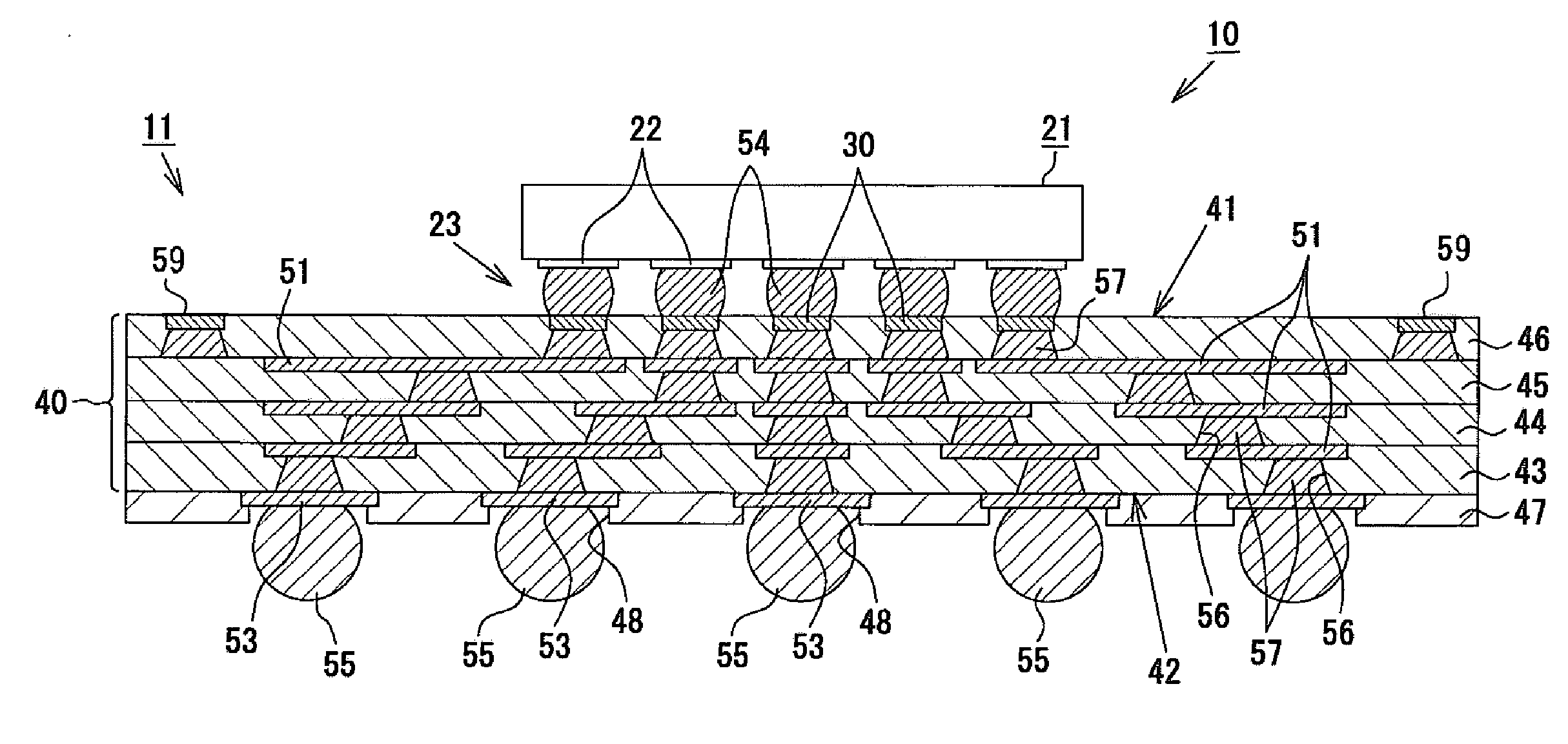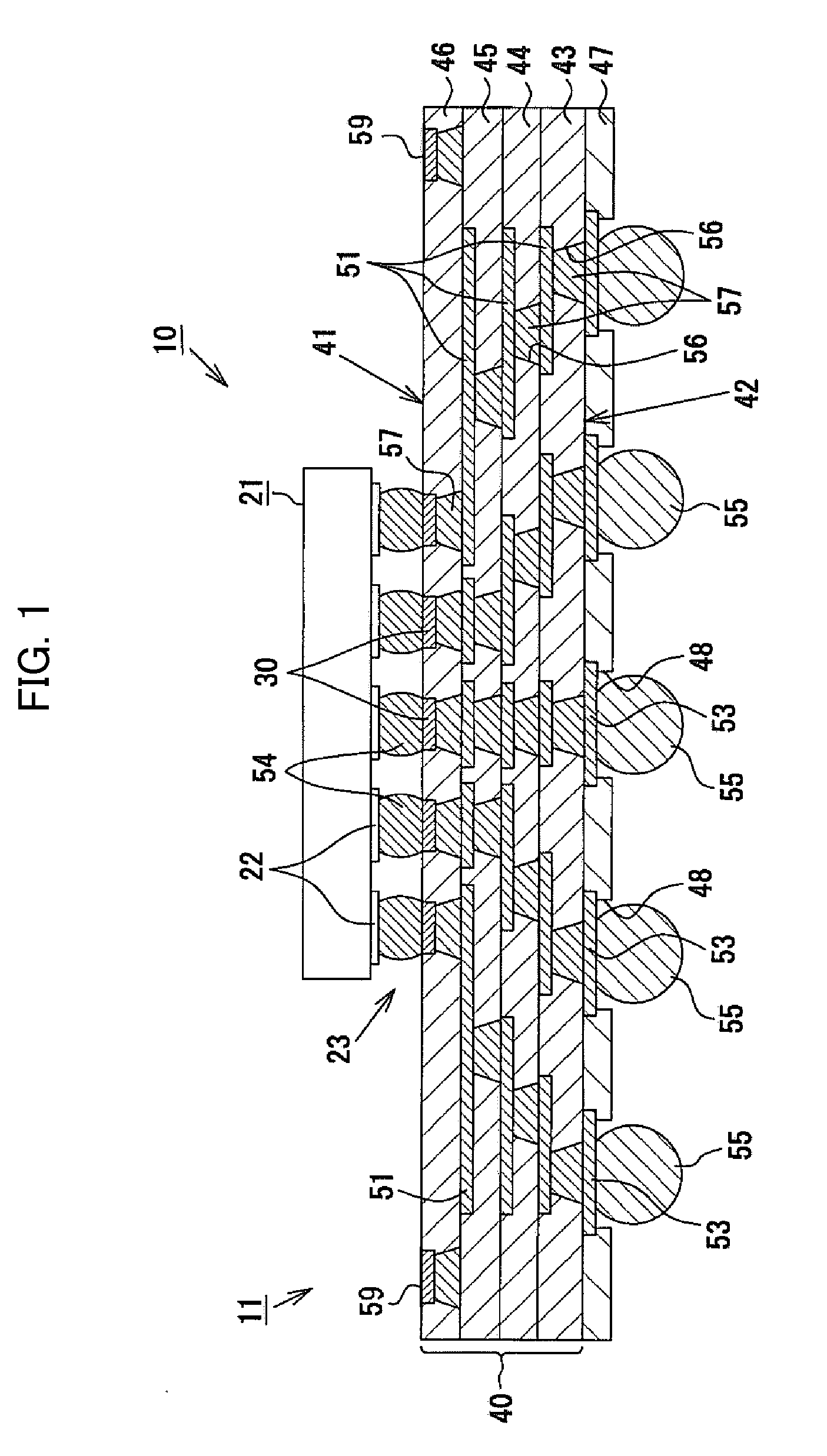Multilayer wiring substrate and method for manufacturing the same
a wiring substrate and multi-layer technology, applied in the direction of printed circuit non-printed electric components association, serial/solid-state device details, borehole/well accessories, etc., can solve the problems of reducing the reliability of connection between the surface connection terminal and the ic chip, unsatisfactory yield of the multi-layer wiring substrate, etc., to achieve the effect of reducing the reliability of connection and deteriorating the shape of the surface connection terminal
- Summary
- Abstract
- Description
- Claims
- Application Information
AI Technical Summary
Benefits of technology
Problems solved by technology
Method used
Image
Examples
first embodiment
1. First Embodiment
[0059]A semiconductor package 10 according to a first exemplary embodiment of the present invention and a method of manufacturing the same will be described in detail with reference to FIGS. 1 to 21.
[0060]As shown in FIGS. 1 and 2, the semiconductor package 10 of the present embodiment is of a BGA (ball grid array) type, and is composed of a multilayer wiring substrate 11 and a IC chip 21 (chip component), which is a semiconductor integrated circuit element. Notably, the type of the semiconductor package 10 is not limited to BGA, and may be PGA (pin grid array), LGA (land grid array), or the like. The IC chip 21 is preferably formed of silicon whose coefficient of thermal expansion is 4.2 ppm / ° C. and assumes the form of a rectangular flat plate whose size is 15.0 mm (length)×15.0 mm (width)×0.8 mm (thickness).
[0061]Meanwhile, the exemplary multilayer wiring substrate 11 does not have a core substrate, and has a wiring stacked portion 40 (laminated structure) comp...
second embodiment
2. Second Embodiment
[0086]Next, a second exemplary embodiment of the present invention will be described with reference to FIGS. 21 to 24.
[0087]As shown in FIG. 21, like the terminal pads 30 of the first embodiment, terminal pads 30A of a multilayer wiring substrate 11 of the second embodiment have a structure in which a copper plating layer 31, a nickel plating layer 32, and a gold plating layer 33 are stacked in this sequence, and the gold plating layer 33 has an overhanging portion 33a along the circumference thereof.
[0088]The multilayer wiring substrate 11 having the terminal pads 30A having such a structure can be manufactured by a method which is basically the same as the manufacturing method of the first embodiment. However, a method of forming the overhanging portion 33a in the terminal forming step which is employed in the present embodiment differs from that employed in the first embodiment. That is, a dry film 76 (thickness: about 15 μm), which serves as a resist (mask), ...
third embodiment
3. Third Embodiment
[0091]Next, a third exemplary embodiment of the present invention will be described with reference to FIGS. 25 to 28.
[0092]As shown in FIG. 25, like the terminal pads 30 of the first embodiment, terminal pads 30B of a multilayer wiring substrate 11 of the third embodiment have a structure in which a copper plating layer 31, a nickel plating layer 32, and a gold plating layer 33 are stacked in this sequence, and the gold plating layer 33 has an overhanging portion 33a along the circumference thereof.
[0093]The multilayer wiring substrate 11 having the terminal pads 30B having such a structure can be manufactured by a method which is basically the same as the manufacturing method of the first embodiment. However, a method of forming the overhanging portion 33a in the terminal forming step which is employed in the present embodiment differs from that employed in the first embodiment. That is, a dry film 91 (thickness: about 15 μm), which serves as a resist (first mask...
PUM
| Property | Measurement | Unit |
|---|---|---|
| surface roughness | aaaaa | aaaaa |
| size | aaaaa | aaaaa |
| size | aaaaa | aaaaa |
Abstract
Description
Claims
Application Information
 Login to View More
Login to View More - R&D
- Intellectual Property
- Life Sciences
- Materials
- Tech Scout
- Unparalleled Data Quality
- Higher Quality Content
- 60% Fewer Hallucinations
Browse by: Latest US Patents, China's latest patents, Technical Efficacy Thesaurus, Application Domain, Technology Topic, Popular Technical Reports.
© 2025 PatSnap. All rights reserved.Legal|Privacy policy|Modern Slavery Act Transparency Statement|Sitemap|About US| Contact US: help@patsnap.com



